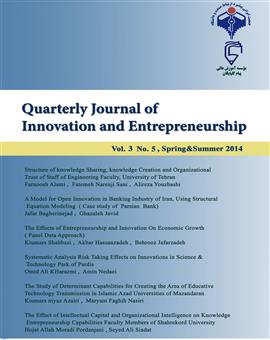-
-
List of Articles
-
Open Access Article
1 - The Effects of Entrepreneurship and Innovation On Economic Growth: Panel Data Approach
Kiumars Shahbazi akbar hassanzadeh behrooz jafarzadeh -
Open Access Article
2 - Systematic analysis risk taking effects on innovations in science & technology Park of Pardis
amin nedaei omidali kharazmi -
Open Access Article
3 - The effect of Intellectual Capital and Organizational Intelligence on Knowledge Entrepreneurship Capabilities Faculty Members of Shahrekord University
Hojat Allah Moraddi Pordanjani ali siadat -
Open Access Article
4 - The study of determinant capabilities for creating the area of educative technology transmission in Islamic Azad Universities of Mazandaran in 2013
مریم فقیه نصیری kiumars niazazari -
Open Access Article
5 - A model for Open Innovation in Banking Industry of Iran: Case study of Parsian Bank
jafar bagherinejad ghazale javid -
Open Access Article
6 - Factor structure of knowledge sharing, knowledge creation and organizational trust (case study: staff of engineering faculty, university of Tehran)
farnoosh alami fateme narenjisani Alireza Youzbashi
-
The rights to this website are owned by the Raimag Press Management System.
Copyright © 2017-2025







